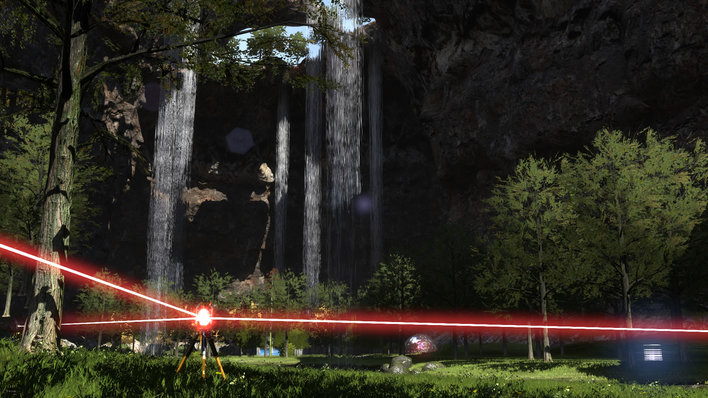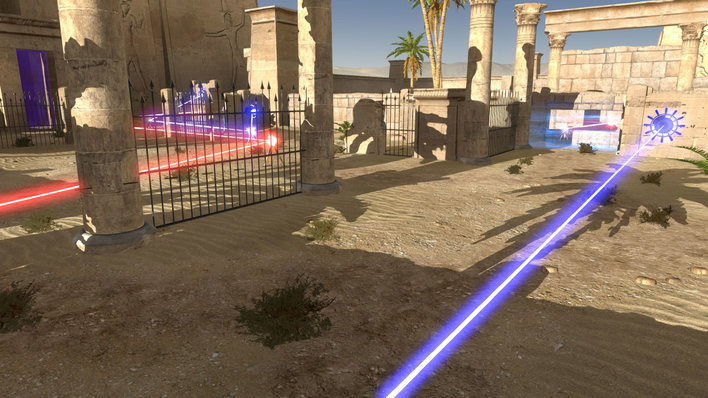The Talos Principle is a game about God. Well, sort of. With plenty of metaphysical references to greater beings, a booming voice over that keeps calling you "my child", and a fair few images of wispily bearded pointing men, there's certainly a spiritual theme of some sort going on here - although quite what it all means is being kept as a closely guarded secret.
You see, the story is just one of the puzzles you'll be left to figure out in the Talos Principle, a new, first person, puzzle oriented game from the team that previously brought us such cranially challenging games as Serious Sam. Don't get us wrong, that's not to say we didn't like Serious Sam - on the contrary, we appreciate decimating waves of angrily screaming, spontaneously combusting baddies as much as the next person - but to say the Talos Principle is a step away from the norm for the Croatian dev team is an understatement.
What hasn't changed is the attention to detail. Plunging you into a Greek/Roman world of marble statues, fresco paintings and elaborate mosaics, you're left to explore the ruins and trees of a gorgeously sun drenched mystery location at your own accord. But as we found out when we went hands-on at gamescom, you won't be able to spend too long admiring the swaying grass, as with 120 puzzles on offer, you're never far away from another head scratcher.

Bouncing lasers around the place is harder than it looks. Nice trees, though.
Rather than being match 3 puzzles and wordy "If I have this many eggs, and this many chickens" questions, the puzzles in the Talos Principle are mostly physics based. Asking you to figure out how to make use of the world around you to open gates, unlock doors, or even just reach a new area, you'll have to explore every inch of the map as you look for clues, and experiment with everything around, until you've figured what order to use what objects in, in order to reach your goal. With no hints if you get stuck, and little in the way of pointers, that can be trickier than it sounds.
Although the demo contained a few specially constructed puzzles, just for gamescom, there were a few repeating themes that kept coming up - doors, jammers, and connectors - the latter of which can be used to bounce lasers from energy crystals to their respective sensors, and open looked doors. It all sounds simple enough, but it's the interplay between these basic pieces that'll have you scratching your head.
In almost every puzzle you come to, there'll be several forcefield doors. While you can pass through these doors, neither enemies, nor your items can - and so you usually have to find another way around. One early puzzle asked you to get your jammer past the shield door. If you pick up your jammer, and click on the shield door, you can deactivate it - but you can't move your jammer once you've put it down. The easy solution was to carry on through the level a bit, find another jammer, and then jam the gate on the one side while you took the other one through - but from there on in, the puzzles got a lot harder. Whether you're having to aim your jammer through a small window to jam a gate, because you can't get it out of a room, or if you have to time your jamming to let an enemy pass through, before springing the shield back up and trapping them inside, there's loads of ways to use a fairly simple puzzle tool - and that's before you add the other elements in.

With several lasers on the go at once, things can very quickly get complicated.
Connectors, when combined with jammers and shield gates, make things a whole lot more complex. Now, rather than simply having to worry about opening and closing doors, you have to worry about bouncing a laser from one point to another using what's effectively a crystal on a stick. Clicking on an energy crystal, before clicking where you want the laser to go, it's up to you to figure out where to place the connector to get the signal from A to B, where something useful will happen. Red lasers can only activate red targets, and blue connectors can only activate blue targets - and should two types of laser cross over, they'll cut each other off.
Even height becomes something you have to think about. One of the puzzles we played through had us place the connector on a box in order to bounce the laser through a small window and onto its target. Doing so usually deactivates a shield door, but with several items to play with, and plenty of doors to open, figuring out how to get your objects from A to B is as much of a challenge as anything else.
Completing each puzzle will earn you a Tetris piece, which you can then put to use to open a mega secret door somewhere in the hub. Plonking each piece you've earnt into a box, and fitting them all together so they make a handy rectangle will unlock the door, and let you carry on your adventure, or otherwise unlock some complex teaser about the story. While it may not be as much of a challenge as the rest of the game, the Tetris sections at least add a bit of variety - and hey, it's Tetris. That can't be a bad thing, right?
While some of the puzzles may have had us breaking out in a cold sweat under the watchful eye of our demonstrator, the Talos Principle is also a lot of fun. With a relaxing atmosphere, some serene music, and a "take as much time as you need" kind of approach, the Talos Principle is very much a game that tests your brain over your brawn, and your logic over your trigger finger - and is exactly the sort of game we can see us losing ourselves in when it eventually releases. Picking up the mantle where Portal left off, the Talos Principle has us excited. More games like this, please.















